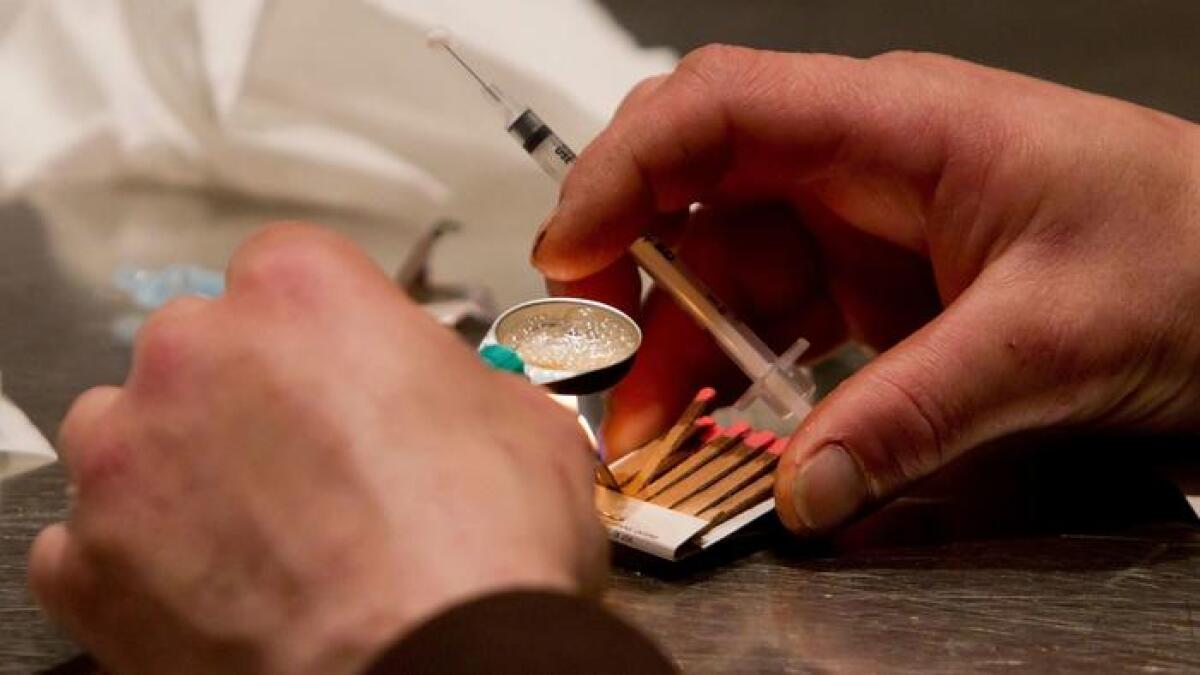Op-Ed: A drug called buprenorphine saved me from heroin addiction. It could save millions more — if we let it

- Share via
While my wife and 2-year old daughter watched TV in the living room, I was in the kitchen, measuring the distance from the tip of my index finger to my armpit.
I needed to know I could pull the trigger with a shotgun barrel in my mouth.
Twenty-six inches. 32 years old. 30 months since my last relapse.
Craving doesn’t begin to describe the feeling. Heroin isn’t ice cream. I craved dope the way a drowning person craves air.
In an opioid addict’s brain, fundamental shifts occur in the normal hierarchy of needs. Neurotransmitters are rewired to seek out dope. This doesn’t reverse when you stop using — it can persist for years, if not indefinitely. For many, sobriety doesn’t get easier with time because it’s not physiologically possible.
After long periods of abstinence, significant dysfunctional activity has been observed at the cellular level in opioid addicts’ brains. This includes an abnormal stress response and reduced connectivity between key areas involving reward processing. In other words, heroin leaves you in worse shape than it found you — and it’s not exactly known for attracting happy people to begin with.
A nice, upper-middle-class, clinically depressed Jewish kid from Westchester, I snorted my first hit at 16. As the bitter, coagulated mix of dope and snot dripped down the back of my throat, my body started to relax. I felt light and warm and safe. My anger and fear and sadness and shame disappeared. Everything was all right — for the first time in my life.
By 18, I was shooting four or five bags a day, caught in a feedback loop of addiction. I used because I hated myself. I hated myself because I used. My parents found out and sent me to Hazelden — the Harvard of rehabs. Upon arrival, I was told addiction is a disease, and remission is only possible by putting your life and will in God’s hands and working the 12 steps of Alcoholics Anonymous.
I tried to explain. Heroin was a choice. I’d been in therapy for more than a decade. My psychiatrist had prescribed Zoloft, Prozac and Paxil. Nothing worked. Depression is emotional pain. Heroin is a pain killer. My counselor said rationalizing and justifying my use was addict mentality and it’s easier to make excuses than admit you have a disease and ask your Higher Power for help.
Epidemiological studies point to an especially high comorbidity of opioid use and depression. Junkies who enter treatment are thought to be four times more likely to have a depressive disorder than the general population, and yet the overwhelming majority of mentally ill addicts in rehab receive addiction treatment only.
In our highly specialized healthcare environment, physicians tend to treat mental illnesses, while addiction care providers are typically not medical professionals. Most drug and alcohol treatment centers use AA’s faith- and abstinence-based model as the foundation for care, which works for many, not all, people. But the high prevalence of that approach has also meant that most rehabs are not equipped to diagnose or treat mental illnesses or prescribe, dispense and monitor medications.
Upwards of 90% of opioid addicts relapse — a significantly higher rate than with most other drugs. Throughout my 20s and into my 30s, I struggled to stay clean. From the outside, I had an enviable life: successful career; great wife; happy, healthy child. It was maddening — to have so much and feel so broken and undeserving.
At 32, family and friends believed I’d been sober for 13 years. I was too ashamed to ask for help. Suicide made sense — less of a stigma than self-medicating with heroin to avoid killing myself.
Instead of buying a gun, I relapsed. It was brief. Looking into my daughter’s eyes, I understood what my counselor at Hazelden meant about a Higher Power. Love was a force greater than myself. Ruby gave me a reason to live, but there was an ocean between will and way. The drowning feeling returned.
Buprenorphine saved my life. Unlike other opioids, buprenorphine is a partial opiate-agonist. Think of it as a life raft or a snorkel. You’re neither high nor drowning, but you’re still in the middle of the ocean.
Any doctor can prescribe Oxycontin and fentanyl. Less than 7% of doctors have the special license required to prescribe buprenorphine as an addiction treatment, and there’s a limit to the number of patients each doctor can treat. In 2016, the Obama administration increased the number from 100 to 275 — where it stands today.
Numerous studies have shown buprenorphine to be a safe and effective short- and long-term treatment for opioid addiction, but it remains very inaccessible. Buprenorphine is further marginalized because its use is considered contrary to the complete abstinence goals of some 12-step groups. Narcotics Anonymous, for example, defines “clean” as being free of all drugs, including medication-assisted treatment, and has cautioned against “the substitution of one drug for another.” Yet the U.S. Department of Health and Human Services has pointed out that such treatment is greatly underused partly because of “misconceptions about substituting one drug for another.”
Suboxone is the most commonly prescribed drug containing buprenorphine. Some experts believe it can be misused. Clearly, they haven’t snorted or injected it. Crushing the drug activates the naloxone that is combined with it, which triggers instant onset of acute withdrawal. This serves as a deterrent to misuse and relapse. Naloxone will counter any opioid entering the bloodstream during buprenorphine’s 37-hour half-life — which means it would take about eight days for the drug to be fully cleared from your system.
My recovery couldn’t begin without buprenorphine. Once I got in the life raft or put the snorkel in my mouth (pick your metaphor), I started working with an extraordinary psychiatrist to navigate the underlying issues. He recommended a combination of cognitive behavioral therapy and a regimen of antidepressants and anti-anxiety medications, in addition to the bupe.
Addiction is a psychological and physiological disease. If I’m considered fortunate to have the resources to heal, it shows how flawed our system is.
If we were talking about a flu epidemic, it’s hard to imagine the government requiring doctors to get a special license to prescribe the antidote and limiting the number of patients they can treat. If we were talking about any other disease, it would be cruel for leading advocates for patients to stigmatize a form of treatment that works.
Drug overdose is the leading cause of death in Americans under age 50. Until every resource is made available to every addict, we have no reason to expect the trend to reverse.
It takes one second to feel the effect of a shot of heroin, and a lifetime to recover. At 43, I’m still sober and no longer feel like I’m drowning, but I haven’t made landfall. Sometimes I can see a vague silhouette on the horizon.
David Poses writes and speaks about addiction and recovery, and mental health.
More to Read
A cure for the common opinion
Get thought-provoking perspectives with our weekly newsletter.
You may occasionally receive promotional content from the Los Angeles Times.










